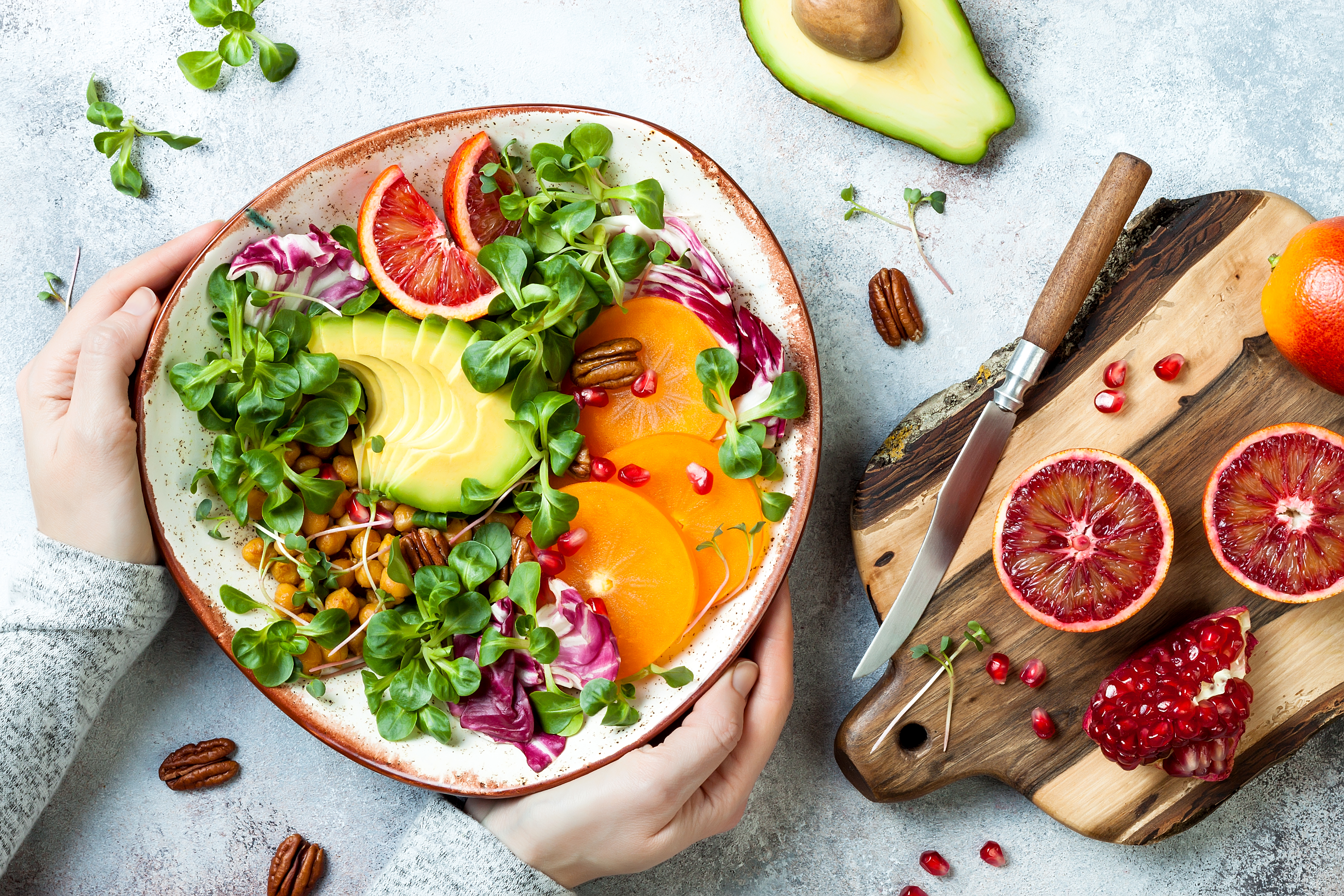
Adjusting to a new routine can be difficult. The COVID-19 pandemic has led to big changes in schedules, structure, and stress for many of us. It can be hard to strike the balance of maintaining healthy habits and remaining flexible to the curve balls we continue to be thrown during these difficult times. Below are 10 tips to help maintain a healthy lifestyle without adding unnecessary stress or pressure.
- Keep food favorable, healthy, and exciting with pantry staples.
Herbs and spices are a great way to add flavor to food. Dried herbs and spices are shelf-stable, and fresh herbs are an inexpensive addition to your grocery list when you do go to the store. Similarly, acid can help brighten up dishes. Vinegars are easy to keep on hand, and citrus, like lemon and lime can last for a few weeks. Products like tomato paste, anchovy, miso, and soy or fish sauce can also pack a lot of flavor with just a dash and are shelf or fridge stable for a long time.
- Aim for a balanced plate at meals.
Aim for balanced meals as much as possible. Try to have a vegetable at most meals. When buying fresh produce, think about how long they last. Use more delicate produce such as lettuce and cucumbers before hardier veggies such as potatoes or cabbage. Frozen or canned veggies are also healthy alternatives that do not go bad quickly. For canned veggies, aim for low sodium products, and rinse and strain. Lean proteins and higher fiber, whole grain carbohydrates will round out a balanced meal.
- Create small amounts of structure where you are able.
If you are at home, try to keep a consistent routine, aim to go to sleep and get up at around the same time each day. Continue with regular meals and snacks and try to eat every 4-6 hours. Try to do some meal planning. Think about staples you need and use often, and what you need on hand to be able to make healthy meals.
- Be prepared to be flexible.
Nothing about what we are going through now is normal, so it’s ok for things to look and feel a little different. Remember to have some grace with yourself if everything isn’t perfect. The grocery store may be out of something, you might forget something, or you might decide to order in, or even bake something yummy, all of that is ok. When planning and shopping for the week, think about food items and recipes that can easily take substitutions, and buy food items you can use in multiple ways over the week. Take advantage of down time to do some prep and use leftovers.
- Have Fun!
It’s ok for food or cooking or baking to be enjoyable and a source of comfort during all of this. It is all about balance and moderation. It’s also ok if it is none of those things. Explore ways to find joy in eating and food preparation. Can you get the family involved? Can you get together with friends and loved ones through a video chat for meals?
- Move Your Body.
Find ways to move your body most days. This can happen in a variety of ways, such as getting outside and taking a walk, doing a YouTube video, or having a dance party in your living room. Some people may enjoy the structure of an exercise routine during this time, but if that is too much for you currently, that is fine! Focus on what is fun and gets you up and using your body.
- Don’t Forget about Fiber.
With all the changes happening during the COVID-19 pandemic, including reduced frequency of grocery shopping, and larger reliance on pantry staples, it can be easy to miss out on fiber. Fiber is found in fruits, vegetables, whole grains, and beans. Make sure to get plenty of fiber by incorporating fruits and veggies with meals and snacks (frozen and canned still count), choosing whole grains, and using beans. Canned beans are a nutritious protein source that can be the basis of a variety of meat-free meals.
- Have Healthy Snack Options on Hand.
If you are at home more, chances are you are snacking more. While it is ok to enjoy some of your favorite snack foods, it is good to balance those with healthier options as well. Healthy snacks to stock up on include popcorn (aim for air-popped or one without a lot of added butter and salt), fresh, frozen, or canned fruit (in juice), raw veggies (with a dip like hummus or yogurt-based Ranch dressing), nuts, string cheese, yogurt, and cottage cheese.
- Practice Mindfulness.
Spending more time at home is a great chance to get reconnected with your natural cues. Start paying attention to your physical hunger and differentiate that from “hunger” that comes from boredom, anger, or stress. Also pay attention to what you are craving to eat and explore what happens when you listen to your body’s signals around when to eat when you are full, and what you want to eat.
- Stay hydrated
Adapting to a new routine might mean that you aren’t drinking as much water as you normally would, or that you are drinking less water and more of other beverages. Staying consistent with hydrating beverages, and not overdo it with sugary, caffeinated, or alcoholic beverages.

Notice: Undefined variable: aria_req in /home/v9lebc6g7vjc/healthsmart.billingsclinic.org/wp-content/themes/weightsmart/comments.php on line 61
Notice: Undefined variable: aria_req in /home/v9lebc6g7vjc/healthsmart.billingsclinic.org/wp-content/themes/weightsmart/comments.php on line 65